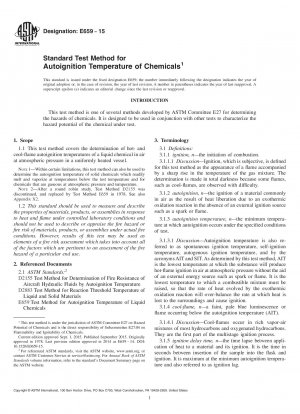ASTM E659-15
Standard Test Method for Autoignition Temperature of Chemicals
- Standard No.
- ASTM E659-15
- Release Date
- 2015
- Published By
- American Society for Testing and Materials (ASTM)
- Status
- Replace By
- ASTM E659-15(2023)
- Latest
- ASTM E659-15(2023)
- Scope
5.1 Autoignition, by its very nature, is dependent on the chemical and physical properties of the material and the method and apparatus employed for its determination. The autoignition temperature by a given method does not necessarily represent the minimum temperature at which a given material will self-ignite in air. The volume of the vessel used is particularly important since lower autoignition temperatures will be achieved in larger vessels. (See Appendix X2.) Vessel material can also be an important factor.
5.2 The temperatures determined by this test method are those at which air oxidation leads to ignition. These temperatures can be expected to vary with the test pressure and oxygen concentration.
5.3 This test method is not designed for evaluating materials which are capable of exothermic decomposition. For such materials, ignition is dependent upon the thermal and kinetic properties of the decomposition, the mass of the sample, and the heat transfer characteristics of the system.
5.4 This test method can be employed for solid chemicals which melt and vaporize or which readily sublime at the test temperature. No condensed phase, liquid or solid, should be present when ignition occurs.
5.5 This test method is not designed to measure the autoignition temperature of materials which are solids or liquids at the test temperature (for example, wood, paper, cotton, plastics, and high-boiling point chemicals). Such materials will thermally degrade in the flask and the accumulated degradation products may ignite.
5.6 This test method can be used, with appropriate modifications, for chemicals that are gaseous at atmospheric temperature and pressure.
5.7 This test method was developed primarily for liquid chemicals but has been employed to test readily vaporized solids. Responsibility for extension of this test method to solids of unknown thermal stability, boiling point, or degradation characteristics rests with the operator.
1.1 This test method covers the determination of hot- and cool-flame autoignition temperatures of a liquid chemical in air at atmospheric pressure in a uniformly heated vessel.
Note 1: Within certain limitations, this test method can also be used to determine the autoignition temperature of solid chemicals which readily melt and vaporize at temperatures below the test temperature and for chemicals that are gaseous at atmospheric pressure and temperature.
Note 2: After a round robin study, Test Method D2155 was discontinued, and replaced by Test Method E659 in 1978. See also Appendix X2.
1.2 This standard should be used to measure and describe the properties of materi......
ASTM E659-15 Referenced Document
- ASTM D2155 Method of Test for Autoignition Temperature of Liquid Petroleum Products (Withdrawn 1980)
- ASTM D2883 Standard Test Method for Reaction Threshold Temperature of Liquid and Solid Materials
ASTM E659-15 history
- 2023 ASTM E659-15(2023) Standard Test Method for Autoignition Temperature of Chemicals
- 2015 ASTM E659-15 Standard Test Method for Autoignition Temperature of Chemicals
- 2014 ASTM E659-14 Standard Test Method for Autoignition Temperature of Liquid Chemicals
- 2013 ASTM E659-13 Standard Test Method for Autoignition Temperature of Liquid Chemicals
- 1978 ASTM E659-78(2005) Standard Test Method for Autoignition Temperature of Liquid Chemicals
- 2000 ASTM E659-78(2000) Standard Test Method for Autoignition Temperature of Liquid Chemicals
- 2000 ASTM E659-78(1994)e1 Standard Test Method for Autoignition Temperature of Liquid Chemicals

Copyright ©2024 All Rights Reserved